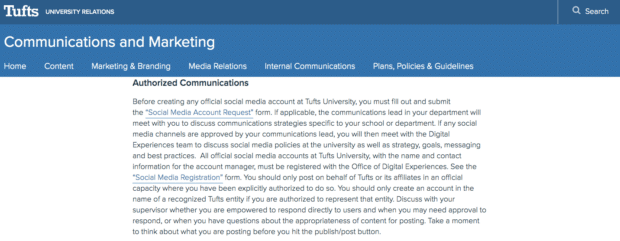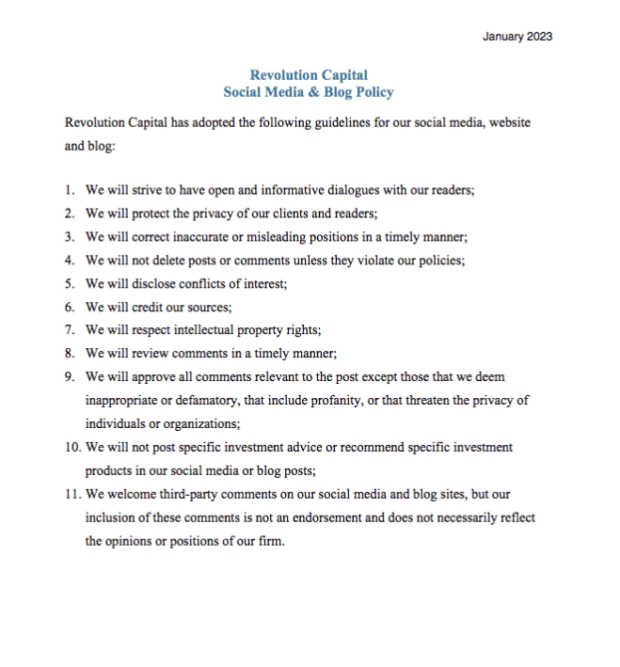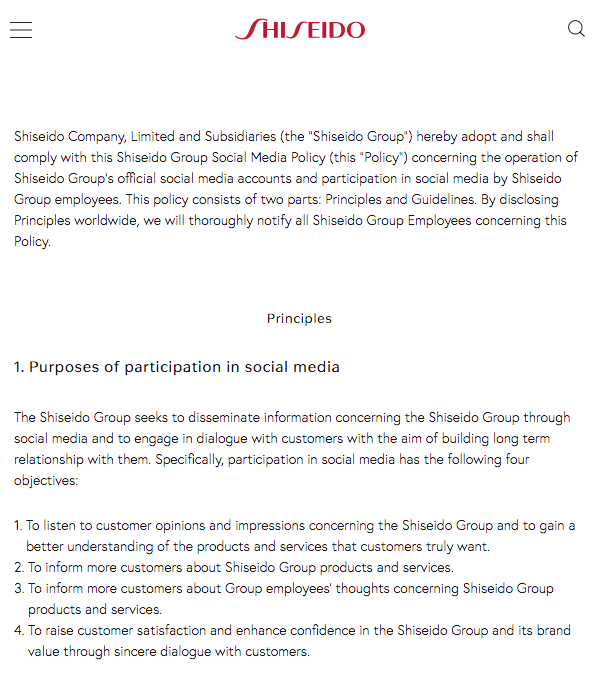A social media policy is a crucial tool for any organization—a code of conduct that protects your business’ reputation and enables employees to stay out of trouble.
Read on for everything you need to know about creating a corporate social media policy, including social media policy examples and a template to help you start your own social media policy today.
A social media policy is an official company document that provides guidelines and requirements for your organization’s social media use.
Your social media policy is intended to cover your brand’s official channels, as well as how employees use social media, both personally and professionally.
Social media policies apply to everyone from the CEO to summer interns, so they need to be easy to understand. These documents can be part of wider social media marketing strategies, or live with onboarding materials and other company policies.
An official company social media policy is an important document. It helps maintain your brand voice while mitigating social media risks. Here are some of the most important reasons to implement a social media policy.
Maintain your brand identity across channels
You likely have multiple people managing multiple accounts across multiple channels. A solid social media policy keeps things consistent and on-brand.
Protect yourself from legal and regulatory challenges
A well-crafted and enforced social policy protects you from falling afoul of rules and regulations. The consequences of breaking them can be major — accidental insider trading, for instance.
Prevent a security breach
A solid social media policy combined with proper security protocols helps protect your accounts against phishing, hacking, and impostor accounts. Including security guidelines in your policy will help ensure employee passwords are changed frequently and meet high standards, and set rules related to using social media on company equipment.
Respond quickly if a crisis or breach does happen
Despite your best efforts, a breach or crisis could still happen. Sometimes the violation or crisis comes from a part of the organization that has nothing to do with social media. You’ll still be expected to address it on social channels.
A social policy makes sure you have an emergency response plan in place.
Clarify employees’ social media responsibilities
You can’t assume employees or associates will make the right call on social media unless you specifically spell it out. So, for example, if you don’t want them to post while wearing their uniform, say so.
Encourage your employees to amplify your brand’s message
All of that said, you don’t want to discourage employees from amplifying your brand message on social media. When you’ve got big product news or a message to share, it’s great to have your whole team on board.
But that can be a delicate dance. If someone has your company name in their bio, does that mean your brand endorses their drunken Vegas vacation? A clear social media policy for employees helps your team know what they can and should share on social, and what they should skip.
Social media policy template
If you’ve heard enough and you’re ready to dive into creating your own policy, go ahead and download our free social media policy template and get started. But if you’re dying for more detail, here you go: everything that you should include in your company’s social media policy
Create guidelines for appropriate online behavior
There are some things you don’t think you have to tell people — don’t take your pants off at church, for example. But when your company’s social media reputation is on the line, you can’t make assumptions about etiquette. Spell out exactly what is appropriate and what is not so that you never have to reprimand an employee for posting a screenshot of your banking information.
Your social media guidelines may include things like…
- No hate speech
- No confidential company info
- No profanity
- Social media posts should use proper spelling and grammatical conventions (avoid slang)
- Emojis are OK in moderation (maximum one per post)
- No reposting or sharing content without fact-checking or confirming its original source
Security guidelines
At a minimum, the security section of your social media policy should include the following:
- Rules related to personal social media use on business equipment
- Social media activities to avoid, like quizzes that ask for personal information
- Which departments or team members are responsible for each social media account
- Guidelines on how to create an effective password and how often to change passwords
- Expectations for keeping software and devices updated
- How to identify and avoid scams, attacks, and other security threats
- Who to notify and how to respond if a social media security concern arises
Plan for customer contact
Social media isn’t just a one-way communication tool. You’ll (hopefully!) have followers commenting on your posts and sending private messages.
Don’t leave those customer or client interactions up to chance. Should complaints be handled directly by a particular department? What’s your strategy for de-escalating a tense situation?
Take a moment in your social media policy to clarify just how to respond to questions or concerns — whether positive or negative.
Outline how to deal with questionable content
Your brand reputation on social media is informed by what you post, of course. But what other people are saying about you can be impactful too — for better or for worse.
Social listening tools can help your company stay on top of mentions and comments, but it’s your corporate social media policy that will determine what to do if you spot a strange rumor or unsanctioned intel online.
For instance, McDonalds should probably prepare for someone to eventually take this April Fools joke out of context. How will they set the record straight?
Describe the process employees are expected to follow when coming across misinformation, news leaks, confidential information, or other questionable content regarding the company on social media.
Of course, questionable content doesn’t always target a company: make a plan for helping employees who may face harassment or threats over social media, too.
Determine the approval process
Your social media policy should clarify who needs to be involved in every post. If there are people who need to approve content before it goes live, their contact info needs to live in the social media policy document.
Clarify personal social media use
Even if your company isn’t on social media, your employees definitely are. Including a section in your social media policy about appropriate behavior on personal social media accounts is important.
Of course, you can’t dictate what people can and can’t say when they’re off the clock. The BBC is learning this lesson the hard way as employees have raised concerns about the news organization’s ban on “virtue signaling.”
But businesses are within their rights to set ground-rules regarding work-related content.
For example, is it all right if employees include company info in their social media bios, or is that potentially problematic? Are employees permitted to share photos from the worksite on their social accounts? What about photos of themselves in their company uniform?
Make a decision about where the line is, and then stick to it — for employees at all levels.
How to handle a PR crisis
Consider this the “in case of emergency” section of your social media policy. When everything goes wrong, how do you plan to make it right?
If you need some inspiration for crafting your perfect PR solution, check out this post on tips for managing a social media PR disaster.
An overview of copyright law
Despite what meme culture would have you believe, copyright law is alive and well. While some random kid on Twitter probably doesn’t have to worry about Disney coming after him for posting a Photoshopped image of Simba, as an organization, you’ll want to steer clear of any potential legal issues.
A British makeup brand found itself in court last winter when Warner Music sued it for using unauthorized songs in Instagram and TikTok videos.
(Iconic London still is using commercial songs in its Instagram videos — and while we can’t confirm if they paid to license these ones, we can confirm they’re bops.)
Familiarize your team with common copyright issues — here’s a primer on image copyright to get you started — and consider creating a clear checklist to make sure everything shared online is compliant with copyright law.
Describe the consequences of breaking the social media policy
The grand conclusion of your social media policy magnum opus? A clear description of the discipline process if someone fails to comply with the policy. What happens if someone doesn’t follow these guidelines?
As important as it is to be clear, it’s also critical to be consistent. Playing favorites or picking and choosing who to discipline is a recipe for bad corporate culture or worse, a PR disaster when someone goes public with what they view as unfair treatment.
Set a review date
Social media changes fast. This means your social media policy should be regularly reviewed to make sure it’s keeping up the pace. Include in your social media policy how frequently reviews will happen (once a year? quarterly?) to ensure expectations are always up-to-date and accurate.
Ready to start your own social media policy? Get started with our free template.
Social media policy examples
Sometimes there’s nothing like a real-world example to get things going. Here are some great ones to model when creating your own social media policy.
Bonus: Get a free, customizable social media policy template to quickly and easily create guidelines for your company and employees.
The Government of BC

Governments aren’t always known for being on top of things like technology, but we’ve gotta say: we’re impressed with how interactive and accessible the B.C. government has made its social media policy. The website is ultra clear and easy to read and navigate, even featuring potential scenarios.
Tufts University

This U.S. university has a thorough social media policy that is available online, with links to other relevant documents embedded throughout — such as a link to an application for an official Tufts social media account.
This social media policy also incorporates accessibility recommendations. If this is something that’s important to your company’s diversity and inclusion efforts, you may wish to include these details as well. (More on accessibility and social media here!)
Revolution Capital

This social media policy is a reminder that these documents don’t have to be long. Particularly for a smaller organization with fewer people involved with social, a short-and-sweet list of rules — like this one from Revolution Capital — may make more sense as a reference document.
Shiseido

The Shiseido Company breaks its policy into two parts: purpose and guidelines. By outlining its objective for being involved in social media in the first place, Shiseido gives all of its social media managers a clear guiding light. Understanding that the social media accounts exist to improve customer satisfaction creates an expectation that posts will be courteous and helpful every time.
Adobe

Adobe includes its social media policy for employees within a broader business policies document. Ultimately, social media is just one facet of the way your team members may be representing your brand, so it might make sense to connect it to a bigger-picture code of conduct.
1. Download our social media policy template
It’s free, and it asks all the questions you need to get started. Click below to download!
Bonus: Get a free, customizable social media policy template to quickly and easily create guidelines for your company and employees.
2. Seek input from stakeholders
Every corporate social media policy is going to be unique. You can probably get some great ideas about what your specific organization needs from:
- your product’s power users
- the marketing team
- the social team
- the HR team
- any public spokespeople
- your legal team
Don’t forget to get regular employees involved in the discussion. After all, this policy affects all of them.
This doesn’t mean you need feedback from every single employee. But do get input from team leads, union reps, or others who can represent groups of employees to let you know about any ideas, questions, or concerns.
As you draft your policy, don’t get caught up in tutorials or details. The nitty-gritty will inevitably change, and fast. Focus on the big picture.
3. Decide where your policy will live
We highly recommend adding your policy to your employee handbook so that new hires can work through it during onboarding.
But where will existing employees access it? Will it live on your company intranet, or shared drives? Depending on your organization’s needs, you may consider posting it to your external website as well.
4. Launch it (or relaunch it)
Whether it’s a revision or a brand new document, you’ll want to make sure everyone is aware there’s new information they need to know. Whether you announce it via internal email or at an all-hands meeting, make sure you leave plenty of room and opportunity for questions.
If you’re launching a new update, include a list of key changes and a revision date.
5. Schedule an update for next year (or even next quarter)
It’s not uncommon to see social media policies that date back to the dark ages of 2013 or 2011. (You can tell because they use buzzwords like “Web 2.0” and “microblogs.”)
Social media is in constant flux, and your social media policy will need regular updates. Social networks and functionalities change, new social media sites emerge, and others fall.
Your social media policy can’t just sit in a drawer (or a Google Doc.). Those policies from the early 2010s could not have anticipated the rise of TikTok or the constant level of connection people now have with their mobile devices.
Committing to an annual, biannual, or even quarterly review will ensure your policy stays useful and relevant. At the very least, you’ll want to ensure all the details and contact information are up to date.
6. Enforce it
Creating a social media policy is great. But if no one’s enforcing it, why bother?
Your social media policy should include a schedule of regular audits to identify new accounts that claim to represent your company. And you should make sure your social policy includes details of the consequences for breaching the requirements, so no one is surprised by disciplinary action if they break the rules.
Finally, your team should engage in social listening. This will identify social conversations about your brand and any posts (by employees or otherwise) that go against your policy.
Pro tip: Social listening is super easy to get started with in Hootsuite. Every Hootsuite plan includes everything you need to get started with social listening so you can track what people are saying about you, your top competitors, and your products — up to two keywords tracking anything at all over the last seven days.

If you’re a bigger organization that really wants to invest in helping its employees post appropriately on social media, we suggest an employee advocacy solution like Hootsuite Amplify.
Amplify serves up pre-approved, on-brand content for your employees to share across their social networks in seconds.
Easily manage all your company’s social media profiles using Hootsuite. From a single dashboard, you can schedule and publish posts, engage your followers, monitor relevant conversations, measure results, manage your ads, and much more.








